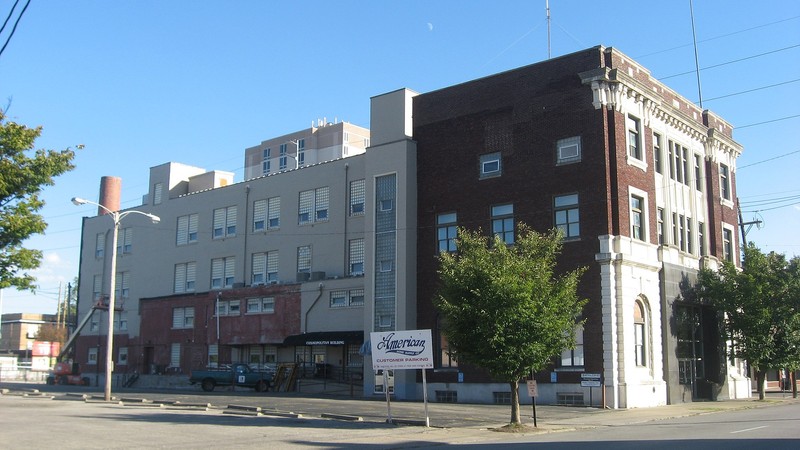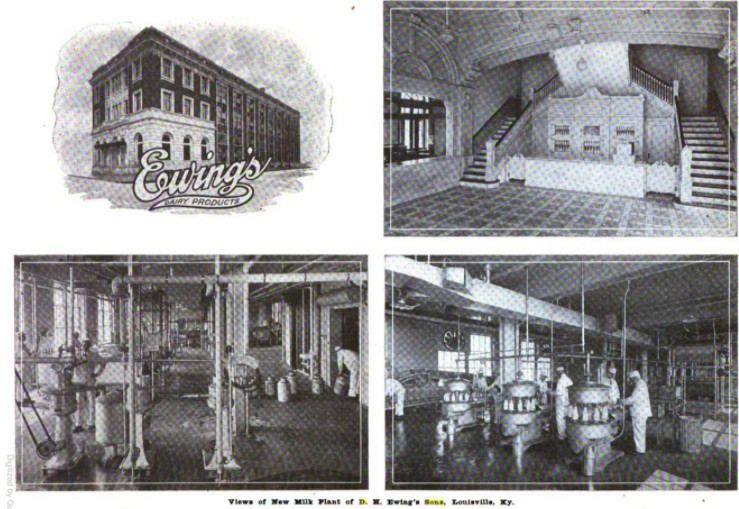D.H. Ewing & Sons Creamery
Introduction
Text-to-speech Audio
Images
D.H. Ewing & Sons Creamery

1918 photos and prints of the Ewing & Sons' Creamery from the December 1918 issue of The Creamery and Milk Plant Monthly

Backstory and Context
Text-to-speech Audio
D.H. Ewing § Sons Creamery built the property in 1917 and remained in the building for several decades. The company arose three generations earlier when D.H. Ewing established a small dairy products trade. Its elegant exterior is one of the many fine buildings erected in Old Louisville during the nineteenth and early twentieth centuries. The Creamery is also historic because it represents a nation in the midst of transitioning from agrarian to urban (which included a growing female workforce) and the resultant need for the processing and transportation of milk from farms to people's homes.
The business represents the heightened demand in urban communities for pasteurized milk and the coinciding need to revolutionize the production speed and efficiency to meet that demand. Indeed, milk production and consumption during the early twentieth century differed significantly from the much more agrarian United States of the early nineteenth century. In a world dominated by small towns and farms, most drank milk within hours of its production, limiting bacteria's proliferation. However, as the United States grew more urban by the early twentieth century, many milk consumers no longer lived near farms. Urbanization and the changing workforce culture changed milk habits, too. Many women worked, making breastfeeding nearly impossible. Also, enhanced trust in human ingenuity led some scientists and academics to praise cow milk over the more "primitive" breastfeeding method. Thus, an abundance of milk had to be transported and distributed throughout the nation's cities.
However, as part of a growing consciousness of health and wellness during the early twentieth century, including food production and sanitation, health officials made people aware of research that pointed to unpasteurized milk as a leading cause of child sickness and mortality. For years, milk routinely sat for days in unrefrigerated storage, which led to microbial growth and consequent illnesses, especially among its biggest drinkers: children. Hence, businesses like D.H. Ewing quickly adapted to pasteurization and adhered to new cleaning standards. The plant, which had the capability of processing 5,000 gallons of milk per day when it opened, designed a modernized cold room and installed several machines to help with the bottle cleaning process, aided by abundant water drawn from the artesian well located in the plant's basement.
In 1930, the company consolidated with the Gray-Von Allman Dairy Co. to become Ewing Von Allman Dairy. The structure transitioned into an office building in 1953 and today serves as a space for offices as well for the Spalding University School of Nursing.
Sources
Hedgepeth, Marty, "Kentucky Historic Resources Inventory: D.H. Ewing & Sons Creamery." National Register of Historic Places. nps.gov. 1982. https://npgallery.nps.gov/GetAsset/d7c419d0-342a-4fbd-b4ff-7ade21219cda/.
Jung, Lara, "Reimagining the Country: A Landscape of Children's Health and Wellbeing from 1875-1975" (2019). Undergraduate Humanities Forum 2018-2019: Stuff. 9. https://repository.upenn.edu/uhf_2019/9
"New Milk Plant of D.H. Ewing's Sons, Louisville, Kentucky." The Creamery and Milk Plant Monthly 7, no. 1 (1918), 32-33. Digitized from the University of California Library in 2014 by T.D. Cutler and located at Google Books: https://books.google.com/books/download/The_Creamery_and_Milk_Plant_Monthly.pdf?id=CjFCAQAAMAAJ&output=pdf.
Obladen, Michael. "From Swill Milk to Certified Milk: Progress in Cow's Milk Quality in the 19th Century. " Annals of Nutrition & Metabolism 64, no. 1 (2014) 80-87.
Wiebe, Robert H. The Search For Order 1877 - 1920. New York: Hill and Wang, 1967.
By Nyttend - Own work, Public Domain, https://commons.wikimedia.org/w/index.php?curid=22564707
Page 33 of the December 1918 issue of The Creamery and Milk Plant Monthly.
